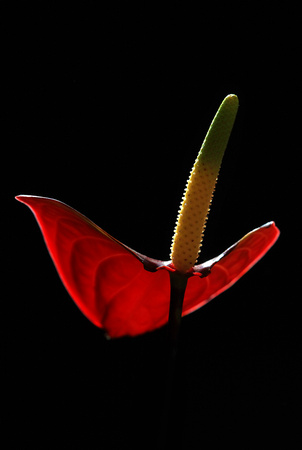Anthurium 1
Anthurium (Schott, 1829), is a large genus of about 600- 800 (possibly 1,000) species, belonging to the arum family (Araceae).It is the largest and probably the most complex genus of this family.Many species are undoubtedly not described yet and new ones are beingfound every year.
They grow in the most diverse habitats, mostly in wet tropical mountain forest of Central America and South America, but some in semi-arid environments. Most species occur in Panama, Colombia, Brazil, the Guiana Shield and Ecuador.According to the work of noted aroid botanist Dr. Tom Croat of theMissouri Botanical Garden, this genus is not found in Asia. It issolely a neotropical genus found in Mexico, Central America and theWest Indies.
Some species have been introduced into Asian rain forests, but are not endemic.
Anthurium grows in many forms, mostly evergreen, bushy or climbing epiphyteswith roots that often hang from the canopy all the way to the floor ofthe rain forest. There are also many terrestrial forms as well ashemiepiphytic forms. A hemiepiphyte is a plant capable of beginninglife as a seed and sending roots to the soil, or beginning as aterrestrial plant that climbs a tree and then sends roots back to thesoil. They occur also as lithophytes. Some are only found in association with arboreal ant colonies or growing on rocks in midstream (such as A. amnicola).
The stems are short to elongate with a length between 15 and 30 cm.The simple leaves come in many shapes. Most leaves are to be found atthe end of the stem. They can be spatulate, rounded, or obtuse at theapex. They may be erect or spreading in a rosette, with a length up to40 cm. The upper surface is matted or semiglossy. The leavesare petiolate. In drier environments, the leaves can take abird's-nest-shape rosette that enables the plant to collect fallingdebris, thus water and natural fertilizer. Terrestrials or epiphytesoften have cordate leaves. Some grow as vines with rosettes of lanceolate leaves. Some species have many-lobed leaves.
The flowers are small (about 3 mm) and develop crowded in a spike on a fleshy axis and called a spadix,a characteristic of the arums. The flowers on the spadix are oftendivided sexually with a sterile band separating male from femaleflowers. This spadix can take on many forms (club-shaped, tapered,spiraled, and globe-shaped) and colors (white, green, purple, red,pink, or a combination).
The spadix is part of an inflorescence. The outer portion of theinflorescence is known as the spathe. Some people like to call thespathe a "flower", however it is simply a modified leaf. The spathe maybe a single color (yellow, green, or white) or possibly multicoloredincluding burgundy and red. That sometimes colorful, solitary spathe: a showy modified bractthat can be somewhat leathery in texture. There are no flowers on thespathe as is sometimes thought. The flowers are found solely on thespadix. The spathe can vary in color from pale green to white, rose,orange or shiny red (such as A. andrenaum). The color changesbetween the bud stage and the anthesis, (the time the flower expands).Thus the color might change from pale green to reddish purple toreddish brown.
The flowers are hermaphrodite, containing male and female flowers. The fruits are usually berries with one to multiple seeds on an infructescence that may be pendant or erect depending on species.
The flowers


